

 Sacroiliac joint pain treatment is now possible for lower back pain with a new implant procedure. A study published in the journal Neurosurgery used randomized controlled trials to show the outcomes of individuals who underwent minimally invasive sacroiliac joint (SIJ) fusion using titanium implants when compared to nonsurgical management.
Sacroiliac joint pain treatment is now possible for lower back pain with a new implant procedure. A study published in the journal Neurosurgery used randomized controlled trials to show the outcomes of individuals who underwent minimally invasive sacroiliac joint (SIJ) fusion using titanium implants when compared to nonsurgical management.
The study consisted of 141 patients with low back pain due to SIJ dysfunction. An estimated 15 to 23 percent of those with osteoarthritis will experience lower back pain due to SIJ dysfunction.
Average pain scores were 82 out of 100 and pain had continued for more than six years. Two-thirds of the patients were taking opioids to ease the pain. Some of the patients had received prior surgery, including spinal surgery.
Two-thirds of the patients were assigned to receive a minimally invasive fusion surgery, while the remainder received nonsurgical treatments, such as physical therapy or steroid injections.
Pain and other outcomes were followed up one, three, six and 12 months later. At the six-month mark nonsurgical patients had the option to receive surgery.
Eighty-one percent of patients who received the surgery found it to be successful. Only 26 percent of patients who received nonsurgical options were satisfied with the treatment. In regards to pain reduction, those in the surgical group reduced their scores to 30 in comparison to the nonsurgical group whose scores only went down to 72. After one year, those in the surgical group continued to experience a decline in pain and disability.
The research supports that the minimally invasive implant surgery can be effective in helping sufferers with sacroiliac joint pain in their lower back.
Sacroiliac joint pain is believed to cause lower back and leg pain. The sacroiliac joint is located next to the bottom of the spine, under the lumbar and above the tailbone. This joint is reinforcement by surrounding ligaments and is very strong. The sacroiliac joint has minimal movement but acts as a shock-absorber.
 There are two main factors that can contribute to sacroiliac joint pain: Too much movement and too little movement. In the case of too much movement, or hypermobility or instability, pain can be felt in the lower back and radiate to the groin. In too little movement, or hypomobility or fixation, pain is felt on one side of the lower back or buttocks and can radiate down the leg. The pain associated with too little movement may be comparable to sciatica pain.
There are two main factors that can contribute to sacroiliac joint pain: Too much movement and too little movement. In the case of too much movement, or hypermobility or instability, pain can be felt in the lower back and radiate to the groin. In too little movement, or hypomobility or fixation, pain is felt on one side of the lower back or buttocks and can radiate down the leg. The pain associated with too little movement may be comparable to sciatica pain.
Other causes of sacroiliac joint pain include:
 Although sacroiliac joint pain may feel like sciatica pain, it’s important not to confuse the two as they are quite different. Unlike sacroiliac joint pain, which is caused due to direct irritation of the sacroiliac joint, sciatica pain is the result of another spinal condition. Spinal conditions that cause sciatica pain include disc herniation, spinal stenosis and spinal fractures.
Although sacroiliac joint pain may feel like sciatica pain, it’s important not to confuse the two as they are quite different. Unlike sacroiliac joint pain, which is caused due to direct irritation of the sacroiliac joint, sciatica pain is the result of another spinal condition. Spinal conditions that cause sciatica pain include disc herniation, spinal stenosis and spinal fractures.
Treatment options, too, differ between the two conditions. Sciatica pain can be treated with cold/hot compresses, epidural injections, pain medication or surgery. Sacroiliac joint pain, however, is best treated with fusion surgery.
Alternative treatment options for sacroiliac joint dysfunction include:
 Physical therapy can be beneficial for a person suffering from lower back pain due to sacroiliac joint dysfunction. There are two types of physical therapy a person can undergo: passive and active.
Physical therapy can be beneficial for a person suffering from lower back pain due to sacroiliac joint dysfunction. There are two types of physical therapy a person can undergo: passive and active.
In passive physical therapy the therapist does the majority of the work, for example, a passive treatment would be the therapist applying ice. In active physical therapy you do the work, including at-home exercises, provided by a registered physical therapist.
It may seem difficult to exercise when experiencing pain but it is recommended. However, it doesn’t have to be intense to achieve benefits.
Exercising can help stretch lower back muscles and make them more flexible. Exercises that should be included to help ease sacroiliac joint pain are aerobic, strength and flexibility. Below are some exercises you can try in order to ease pain.
Hamstring stretch on wall: Lie on your back with your buttocks close to a doorway. Extend your uninjured leg through the doorway while keeping the injured one up against the wall. It’s important to keep your leg as straight as possible. Holding this position for 15 to 30 seconds will allow for a deep stretch.
Quadriceps stretch: Stand arm’s length away from a wall with your injured side furthest from the wall. Keep one hand on the wall for balance and grab the ankle of your injured leg – your foot should be nearly touching your buttocks. Keep your back straight and knees together. Once again hold for 15 to 30 seconds.
Gluteal sets: Lay on your stomach with legs straight behind you. Squeeze your buttocks together and hold for 15 seconds then release. Repeat three sets.
Lower trunk rotation: Lay on your back with feet flat on the floor and bent knees. Tighten your abdomen as if you were going to get hit and push your lower back into the floor. Gently rotate knees from left to right.
Double knee to chest: Lay on your back with feet flat on the floor and bent knees. Tighten your abdomen as if you were going to get hit and push your lower back into the floor. Bring knees to chest and hold for five seconds, release for 10 seconds and repeat.
For low back pain, early physical therapy shows modest pain relief benefit
Early physical therapy has shown to produce modest pain relief for those with low back pain. Considering that ten percent of people experience low back pain at some point in their lives, the option of physical therapy may ease a lot of frustration. Continue reading…
Opioid therapy for chronic pain only effective in 20 percent of women
Women are more likely to experience chronic pain, so a popular treatment is opioid therapy. New research suggests that this long-term use of opioid therapy for chronic pain is only affective in roughly 20 percent of women. Researchers evaluated the effectiveness of long-term opioid therapy in women. Continue reading…
Copyright © www.orthopaedics.win Bone Health All Rights Reserved